Horror Island, House of Horrors, Murders in the Zoo, Night Monster (1933, 1941, 1942, 1946)
Directed by: A. Edward Sutherland, Ford Beebe, George Waggner, Jean Yarbrough
Written by: Clarence Upson Young, Dwight V. Babcock, George Bricker, Maurice Tombragel, Philip Wylie, Seton I. Miller, Victor McLeod
Starring: Bela Lugosi, Charles Ruggles, Dick Foran, Irene Hervey, Lionel Atwill, Peggy Moran, Robert Lowery, Rondo Hatton
CREEPING HORROR – MURDERS IN THE ZOO [1933], NIGHT MONSTER [1942], HORROR ISLAND [1941], HOUSE OF HORRORS [1946]
Eureka move away from science fiction horror and focus on horror with their latest collection of vintage ‘B’ movie mayhem from Universal. I’d been wanting to see Murders In The Zoo for some time, while two of the others I hadn’t even heard of. Shame on me.
AVAILABLE ON BLU-RAY: 17TH APRIL, from EUREKA ENTERTAINMENT

DISC ONE
MURDER IN THE ZOO [1933]
RUNNING TIME: 62 mins
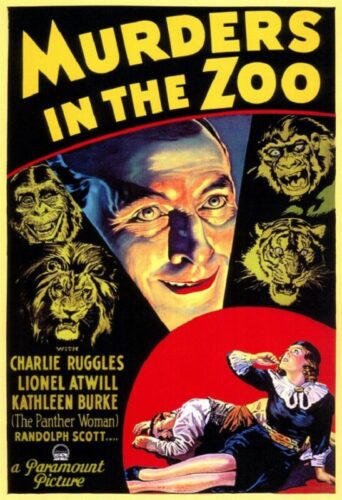
Hunter and wealthy zoologist Eric Gorman is extremely jealous of his wife Evelyn. When a guy tries to kiss her, Gorman is going rather too far when, while on a trip to Indo-China to capture animals for his zoo, he kidnaps him and sows his mouth shut with a needle and thread before abandoning him in the jungle with the wild beasts. Then he finds out that Evelyn is in a relationship with a man named Roger Hewitt and, once back in the States, begins to devise a plan to kill him, though the zoo is beginning to run into financial trouble and the new press agent, Peter Yates, is terrified of most of the animals and considered to be an alcoholic….
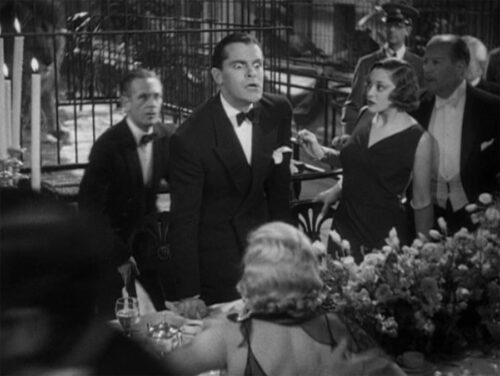
Ah, the dreaded comic relief. Well, probably not dreaded by everyone, but I often find the supposed humorous interventions in vintage horrors and thrillers to be a major irritant. Now don’t get me wrong; comedy can work very well in such films, but it can also fall very flat if the source of said comedy doesn’t make one laugh. When horror fans discuss the best decade for the genre, I immediately think of the 1930’s – or rather the first half of the 1930’s, which threw up a long list of hugely important and memorable chillers. However, producers and studios did like to put in these “funny” characters to offset the chills. This is understandable seeing as, despite their popularity with the paying public, there was a lot of dislike for these films from certain voices which hastened the immense toughening up of the Hays Code in the United States and led to horror films being banned in the UK for four years; indeed, none were even made for almost that duration. The top-billed actor in Murders In The Zoo, a film made by Paramount but one of many films sold to Universal in the 1950’s, isn’t Lionel Atwill, who’d very recently scared audiences in Dr. X and The Mystery Of The Wax Museum, despite him playing the main character who drives the plot, but a certain Charlie Ruggles who’s unfunny and whose character barely effects the proceedings. This is a shame, because it hampers a perhaps minor and straightforward [especially after Paramount’s previous Dr Jekyll And Mr Hyde and The Island Of Lost Souls which remain daring, disturbing and thought-provoking classics], but certainly fun chiller which [otherwise] keeps on moving, has a nice line in dark humour [away from Ruggles], and contains perhaps the greatest villainous turn that Atwill ever did, creating a highly memorable portrait of a Sadean psychopath; he reminded me of Leslie Banks’s murderous human hunter in the previous year’s The Most Dangerous Game. A shame that Atwill later became reduced to a character actor hemmed in by small parts.
After the titles, the main performers are introduced via camera poses, something that may seem odd to modern viewers but which was often done at the time. These are inter-cut with shots of appropriate animals, which along with rather light music might strike one as being inappropriate, but the music gets more dramatic as Atwill is shown and we zoom into a map of Indo-China before dissolving into what must have been a real shocker of an opening scene for 1933 cinema-goers. In the jungle, two natives are holding another man down while Atwill’s Eric Gorman is doing something to him which we don’t see except for a few shots of him holding some strong, along with some agonising sounds of pain. This would normally have been enough, but the man gets up, despite having his hands tied behind his back, and runs into the camera so that we can see his sewed-together lips and a considerable amount of blood on his face! For grisly openers in horror flicks of the time this takes some beating. In the next scene we find out that the man was trying to kiss Gorman’s wife Evelyn. Gorman expresses surprise at his disappearance. “Did he say anything”? he’s asked. “He didn’t say anything” answers a deadpan Atwill with just the slight quiver of his mouth. Somebody finds his belt and a torn part of clothing but Gorman still successfully pretends that he knows nothing – well, except for Evelyn, who, on the journey home, tells her friend Hewitt that she thinks that her husband caused the death. The two are already involved, though we’re not sure if this began on the ship or was already happening. This kind of thing tends to makes the viewer wonder who to empathise with; unless you’re in an open relationship cheating really isn’t cricket and can cause a lot of misery, so we should feel for Gorman, but we know that Gorman is a psychopath, and we’re worried as to what awful fate Gorman – who knows what’s going on – has in store for his rival.
It seems that Gorman won’t allow for a divorce. Hewitt wants to confront him, but Evelyn is worried for his safety. We’re now properly introduced to the zoo, via stock shots of animals seemingly taken from different sources judging by the varying picture quality, with some shots grainier than others. Some chained baby bears won’t be a pleasant site to many today, but unfortunately in 1933 zoos tended to treat their animals poorly. Ex-reporter Peter Yates arrives for an interview as the place’s new press agent. Yes, this is the character played by Ruggles, curiously called a “young man” even though he’s 47 and looks older than that. Zoo boss Professor G.A. Evans is told by his previous boss that Yates has “been booted out of every job in this town” but Yates is also listening to the conversation and tells Evans that this is lies. In the interview Evans says that he hasn’t had a drink “Since two days and three weeks”. This is about as funny as it gets in terms of the Yates character. One of the new creatures is a green mamba, which is strange because green mambas come from Africa and Evans went to Indo-China, but never mind. This particular snake can emit a venom which kills “hundreds of natives very year”. As soon as Gorman is told this, we cut to a closeup up of his face, and and the camera holds onto it as Gorman is clearly thinking and then looking very evil. I think we’re certainly intended to chuckle a bit. Hewitt seems to know a way for Evelyn to get out of her situation but we aren’t told what it is. Does it matter? I suppose not. Yates suggests hosting a fundraising dinner for the rich to raise funds and awareness, and Gorman is very much up for this, though Yates can’t seem to manage a decent speech, while the do is held in a very bizarre locale that’s almost asking for trouble. Gorman again finds himself able to kill and conceal that he did it, and tension rises when it now seems as if anybody could be polished off.
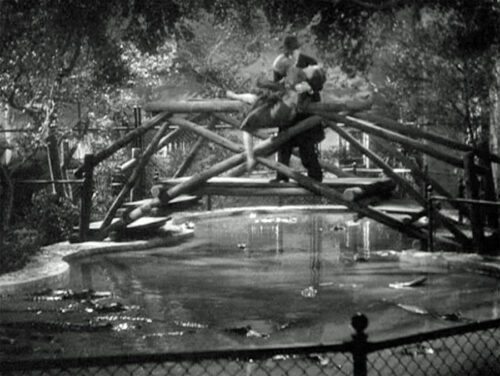
There aren’t many kills, but they’re dwelt on. A push into an alligator pool would normally have the camera cutting away but it doesn’t here, the animals clearly tearing something apart even if we don’t see blood. Gorman’s death is quite agonising. It wouldn’t have been this way a year later after the Production Code became really repressive. Watching this film made me think why hasn’t there been many others based around its central idea of, well, murders in the zoo? There’s been ones with similar situations but I’m really surprised that there hasn’t been a full-on gore fest with animals of different kinds slaughtering victims at the behest of a maniac. But then again it might be hard to get somebody as good as Atwill to play said maniac. He truly manages to chill yet with a slight tongue in his cheek. It’s a shame that he doesn’t get many scenes with Kathleen Burke, the Panther Woman from Island Of Lost Souls, as Evelyn, though they do share one somewhat perverse moment where they have what seems like the beginning of a love scene and he cries “I’m not going to kiss you, you’re going to kiss me” while she’s repelled by him. The intensity of the moment is quite strong even though Evelyn escapes to her bedroom which she locks, Gorman bashing at the door and demanding that she let him in not swaying her. We get a sense of a marriage where Gorman, though he may love Evelyn in his own screwed up way, is extremely dominant and probably abusive, though by today’s standards Hewitt doesn’t seem much better when he tells her “when we’re married, I’m going to run this family”. Burke isn’t anywhere near as effective as she was in Island Of Lost Souls, but then her part in that was quite fascinating and she’s not given as much to work with her put-upon victim character here. She’s just a fearful wife trying to get away, and somebody more conventional may well have pulled off the role better. Also in the cast is Randolph Scott as Dr. Jack Woodford. He’s sort of the hero, while his co-star, Gail Patrick, exist principally to be menaced in the climax.
Yates being afraid of animals is repeated over and over again, and it looks like this supporting role became expanded. You can almost see where scenes were added or made longer to give the character more screen time while other footage was removed. But he’s still just the comic relief – he’s not involved in any way with any major development in the story line except for one, which could have easily replaced a different scene. The forward momentum of the story comes to a screeching halt while we are treated to the antics of the “star”, but thankfully this doesn’t happen that often, and we still get some of the much blacker – and more appropriate – humour that may have dominated in the original cut, such as, at the party, the words “to entertain and intrigue you” causing the camera to do a whip pan to somebody collapsing and dying. The direction by E. Edward Sutherland, who mostly worked in comedy and was one of the original Keystone Cops, is good enough to make one wonder why he didn’t direct more films in this vein, while the cinematography of Arthur Heller makes much use of shadows in a proto-noir way. While not really being a horror classic, Murders In The Zoo offers a fair bit of good stuff, but is weakened by its comic relief character more than any other film of its kind I can think of.
SPECIAL FEATURES
Brand new audio commentary track with authors Kevin Lyons and Jonathan Rigby
I’ve said before that the audio commentaries for these releases tend to be as fun as the films themselves, and this one, which replaces a different track on the Scream Factory North American disc as do the other three tracks, is no exception. Rigby tells us that the early scenes cash in on a craze for jungle movies that existed at the time, and that the producer of a film called Zoo In Bucharest released at the same time wasn’t happy about Murders In The Zoo, while Lyons tells us that the zoo we see was once a film set specifically used for animal footage until it became an actual zoo, and reminds us that a glaring continuity error wouldn’t have been a big deal at the time because films weren’t designed for people to watch repeatedly. Both men like Ruggles and consider him crucial to the plot; maybe one day I’ll agree but it won’t be today, nor tomorrow [the only other film I’ve seen him in is Bringing Up Baby and I didn’t like him in that either]. Nonetheless this track is a terrific listen; enthusiastic, informative and perceptive in just the right doses.
Stills Gallery
NIGHT MONSTER [1942]
RUNNING TIME: 73 mins
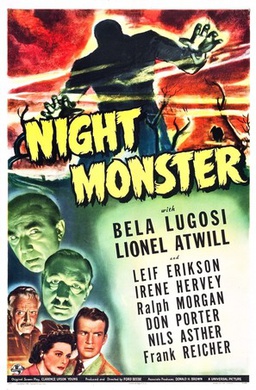
Rumours of mysterious happenings including an unexplained murder surround the swamp-based Ingston Towers, which is inhabited by the reclusive, wheelchair-bound Curt Ingston, along with his possibly insane daughter Margaret, his grim-humored butler Rolf, lecherous chauffeur Laurie, domineering housekeeper Miss Judd, Eastern mystic Agar Singh, elderly hunchback Torque. and sassy maid Millie Carson, though the latter leaves to disappear into the fog with a scream. Hearing the sound is psychologist Dr. Lynn Harper who’s been called to assess Margaret’s sanity, and whose car has broken down, though luckily mystery writer Dick Baldwin is around to help with that. Also at the house are three doctors – Dr. Timmons, Dr. Phipps and Dr. King – who were trying to cure Ingston when his paralysis set in, and who’ve been invited there by him….
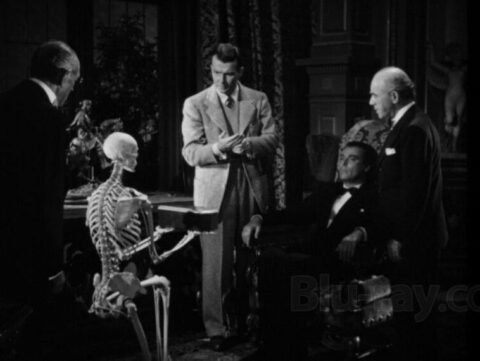
I thought for a short while on how to write this review, because Night Monster is rather similar to another, better known horror film from the 1930’s, and I did consider naming that film to make it easier, though if I did so that would give some important stuff away. Some readers who really know their vintage horror may very well pick up on it anyway, but I can’t really help that. Does Night Monster work well as a mystery otherwise? I would say that it does, the way it leads the viewer to suspect a certain person then changes his or her mind being quite nicely done, while there are enough other suspects to keep things even more interesting. Despite all this, it probably strikes many first-time viewers as being a bit of a disappointment because the two gentlemen who are top billed [a rare thing for Lugosi, surprisingly] are certainly not the main protagonists and have very little interaction with each other; Bela Lugosi is often present but usually just lurks around as his uninteresting butler character, while Lionel Atwill, who was used so well in Murders In The Zoo, isn’t in it much at all as one of the three doctors who feature in the story and who has far less screen time than the others, though he still manages to make the most of every little moment he’s given. In any case, as long as you know this, there should be enough other stuff to enjoy in this fairly pacey entry in the Old Dark House sub-genre, which brings in many of its familiar elements that audiences of the time would have been familiar with [was it made because of the success of the 1939 version of The Cat And The Canary?], along with at least two others common of the era, and which also includes some genuinely creepy scenes in the swampland surrounding the Ingston estate as well as some well-handled murders.
The titles play over the camera panning across a somewhat familiar set of dead trees, darkened ground and fog which is – it must be! – one of the main sets from The Wolf Man – before we cut to the gate to Ingston Towers and Agar Singh being let in by the gatekeeper Torque. Just a few seconds inside the place and we feel that, as Margaret says “the air is charged with death and hatred and something is unclean”. Housekeeper Miss Judd is cleaning up a spot of blood, supposedly secretly, and sends Margaret, who sees the blood, to bed. Already it seems that Miss Judd is trying to drive Margaret insane, with Miss Judd furious when Margaret sends for a psychiatrist. However, somebody else saw the blood – Millie the maid – though her phone call to the police is interrupted by butler Rolf. At least Lugosi gets quite a good entrance here, coming out of a door opening quietly right behind Millie. Laurie the chauffeur sticks up for Millie, who wants to leave, but she has to fight off the affections of Laurie who says “this is the way I get my women, saving them from butlers”. Laurie drives her into the local town, then has to pick up the three doctors who’ve been invited to Ingston Towers by Ingston. The Sheriff tells Laurie that he can’t do anything despite another doctor having been found dead near the house a while ago, strangled, with a spot of blood beside the body. In a rather clumsy bit of plotting, she has to return to the house to get her things, where Torque tells her driver Jeb that she’s decided to spend the night there, meaning that when she comes back out she’s stranded in the fog. We have the first example of an unnerving touch; the frogs and animals in the swamp go totally quiet whenever the killer appears. The gate opens and she runs off into the distance to be enveloped in fog and utter two loud screams while nearby the broken down Lynn, the psychiatrist on her way to visit Margaret, not just hears it but sees something. The lack of music here enhances the effect of a highly atmospheric and sinister scene.
Meanwhile our doctors are wondering why Ingston has invited them. After all, despite their efforts to cure his paralysis, they “left him a misshapen thing hiding from the servants in the house”. Dinner, at which Lynn and her saviour Dick also attend, proves to be interesting, because Ingston is able to eat, via prosthetic arms, courtesy of “money and a local mechanic“. He also says that he can grow new tissues courtesy of Agar Singh, who, before he gives a demonstration, explains that “all matter is really cosmic substance in vibration. When you raise the vibration, you change the cosmic matter”. Sounds simple aye, all about just raising the vibrations! But that’s nothing compared to the initially funny scene where Agar Singh uses his hypnotic powers and his energy makes a humming noise before he makes a model skeleton and a ruby disappear. He explains that the skeleton came from Sicily and that he’d transported it to America using his mind, though he doesn’t mention the ruby. Witnessing this is a new arrival, Constable Gegs, who’s decided to investigate. When one of the doctors is found strangled to death in his room, Begs understandably suspects Agar Singh, but, noticing that Ingston had a reason to dislike the doctors, then thinks it could be him. After all, Dick, a mystery writer though not a very published one despite Ingston claiming that his latest tale was “a masterpiece of horror”, says that one should always suspect the person you’d least suspect. However, a revelation follows concerning Ingston then shows it’s even less likely to be him. So maybe it’s Laurie, though he seems most interested in leching, even trying it on with Miss Judd, replying to her show of surprise with “well why not, you can’t afford to be choosy” What a charmer! Then there’s still the issue of Margaret and Miss Judd. If Miss Judd is really trying to drive Margaret mad, then why? It all fits quite well together despite a final explanation which is bonkers, but then it’s already established that this is one Old Dark House mystery which exists in the world of the fantastique.

The interior of Ingston Towers is full of impressively detailed set design which belies the film’s extremely low budget unless you recognise that it’s really a set from The Wolf Man and Ghost Of Frankenstein. It’s perhaps too brightly lit at times, but nonetheless cinematographer Charles van Enger does a fine job with lots of of noir-like shots; I lost count how many times characters had slight shadows or dark reflections over their faces. The scene where the doctors realise that they were directly responsible for Ingston’s condition has a sense of dread as well as allowing some sympathy for Ingston, who has to be carried everywhere because he can’t walk. Our obligatory romantic couple Dick and Lynn are boring together and the dialogue supplied by screenwriter Clarence Upson Young to show their growing affection awkward, but the relationship between Margaret and the controlling and somewhat mannish Miss Judd carries unmistakable echoes of Rebecca and Mrs Danvers, including a slight lesbian element. The scenes of Fay Helm [Margaret] and Doris Lloyd [Miss Judd] together cackle with uncomfortable tension. The most shuddery scene has somebody standing by a mirror so we see the reflection of the door opening, then we cut to a further away shot of the victim while a huge, extremely menacing shadow approaches and envelopes him in darkness as it gets closer and closer to the camera. Another kill shows the terrified victim, who knows what’s about to happen to him, putting his own hands around his neck. The climax set in the foggy, swampy grounds is quite strong, well staged by the director, serial stalwart Ford Beebe who at times shows a flare for the macabre despite it being something that he rarely dealt with, even if the visual revelation of the killer is a let down, considering that we’ve been led to believe that he or she is horrible looking. Maybe the MPAA had words. After all, this was a slightly grislier film than was the norm at the time, with some blood and a startling “reveal” .
While not really a lighthearted effort, Young provides some amusing dialogue at times, especially for the doctors, with exchanges like this one? You still on glands I suppose Phil”? “Of course, fascinating little structures”. You’d expect Don Porter’s Dick to be a comic character, but he only gets a few minor moments. It’s possible that Lugosi would have been better off playing the Agar Singh role; after all, Nils Athner isn’t very good in said role, not conveying to us at all that he’s a mystic able to do amazing things, while Lugosi had played a similar part in Night Of Terror nine years before which may well have partly inspired Night Monster. Instead, he resorts to giving creepy expressions in an effort to make something of his part. Irene Hervey as Lynn is fine as the heroine. “Nah, she’s no doctor, she’s a dame” says Leif Erickson’s Laurie about Lynn, and some sarky comments are made about Agar Singh too, though this is deflected by a scene near the end, even if you think about it the character behaves very oddly for some time. The music score is the usual cobbling together of familiar cues from the likes of Hans J. Salter, Frank Skinner and Charles Previn. Some tracks will likely be familiar to you even if you can’t name where they came from; in fact it’s very hard to work out where some of these pieces were first used. Some things are left unexplained, such as two characters disappearing somewhere along the line without explanation. And why the drops of blood? Nonetheless Night Monster, one of those neglected Universal horrors that have fallen through the cracks because they aren’t part of a series or feature any of the usual monsters, deserves more exposure. It’s really pretty well done and rather satisfying.
SPECIAL FEATURES
Brand new audio commentary track with author Stephen Jones and author / critic Kim Newman
Jones actually talks more than Newman here, but then again he does say that this film is a favourite of his. The pair provide another lively, enthusiastic and informative track, its overall aim being to help restore the reputation of a film they feel is hugely underrated [not to mention neglected, Newman says this may be its British debut] and deserves more praise than some of the more well known Universal horrors of the time; they certainly succeed in this, though I do think they’re a bit harsh on the Lon Chaney Mummy movies! Jones thinks it may have been heavily truncated somewhere along the line and provides more detail than the previous commentary did on the court case which severely weakened Atwill’s career, while Newman talks about something I’ve always thought to be a major thing but which doesn’t seem to be mentioned much – the direct link between horror and film noir. Both sing the praises of Irene Hervey in a truly absorbing listen.
Stills Gallery
Trailer
DISC TWO
HORROR ISLAND [1941]
RUNNING TIME: 61 mins
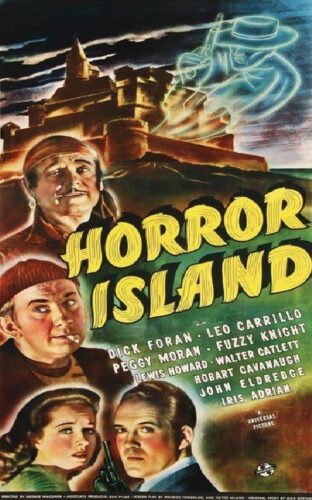
Down-on-his-luck entrepreneur Bill Martin has inherited an island off the coast of Florida called “Morgan’s Island”, but it’s of no value to him – well, until he and his friend “Stuff” Oliver save a peg-legged old sailor, Tobias Clump, from drowning after being pushed into the water by a “phantom” , who took one half of a map which points to the island and shows the way to infamous buccaneer Sir Henry Morgan’s twenty million dollar treasure. Then cartographer Jasper tells him the map is fake, so Bill thinks of making some money by organising a fake “treasure hunt” for fifty dollars apiece. Signing up are Jasper, Bill’s cousin George who wants to buy the island, heiress Wendy Creighton and her bored boyfriend Thurman Coldwater, small-time gangster Rod Grady and his wife Arleen, and dimwitted private investigator, McGoon….
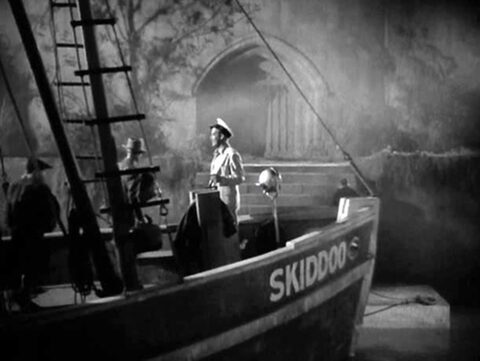
While I’m certainly of the opinion that many of the Old Dark House mysteries can be considered horror, I’m not sure that Horror Island qualifies. In fact several times, while I was watching it, it occurred to me how kids would probably like it, until I realised that, unless parents are true film fans and watch black and white films as well as colour, today’s youngsters are unlikely to find monochrome visuals appealing. It was very different when I was young – the likes of the Tarzans and the Basil Rathbone Sherlock Homes series were often shown on TV [the latter usually at 6pm on BBC2!] and us kids would watch them and chat about them in the school playground, while those who had cool parents or parents who went to sleep early would stay up late and enjoy the Universal monster movies. Things are different now. But I say that kids would probably like Horror Island because its chill level is very low if still present, and should therefore be, along with the light tone, both very enjoyable and very suitable for young viewers. In fact elements of it, right down to some of the characters, are similar to Scooby Doo, Where Are You!, so it’s possible that it was an influence even if it’s little-known, and was clearly influenced itself by The Ghost Breakers. I suppose, like Night Monster and House Of Horrors, it was doomed to second tier status by being a Universal Horror which wasn’t part of one of their main franchises, and perhaps doomed even further by, as I’ve already said, by not being truly a horror film. However, don’t let all that put you off; this is one hugely diverting lark which packs in most of the things you’d want; a creepy mansion, lost treasure, a map, a secret passageway behind a bookcase, a group of characters – many of whom seem a bit suspicious, a killer on the loose, etc, into one neat, tight little package. In fact you could say that it’s too tight; its one hour running time could easily have been extended, though I didn’t notice any evidence of heavy cutting.
The castle is glimpsed behind the titles, then we get a perfect opening. A man with one leg, Clump, is being followed by a man in a hat and cloak who moves out of sight whenever his quarry looks in shop windows because he knows he’s being followed. Eventually the pursued man is surprised by a policeman who asks him what he’s doing out so late. He finds out from him where a certain Bill is before leaving, to be followed by the other man again – and it’s definitely a living human, even though he’s often referred to as The Phantom. Bill is busy trying to convince Oliver that his latest project, “Condensed stuffing for Christmas turkey” can’t miss, but apparently he said that about a lot of other things, and they all flopped. Then a cry for help leads them Clump who was pushed into the water by his follower who not just tore off half of a map he had but took his leg – fortunately though it was his false leg. Bill is excited about this treasure on his island, but he keeps being hassled by visitors, and he prefers to not answer to his real name, because he has lots of creditors after him. One guy he fights, but that turns out to be his cousin George, who wants the island as “his hideaway for the weekend” [I wonder what that entails?!], doesn’t like to take no for an answer. Well, that’s one suspicious person already, but surely he can’t be the Phantom, because we’ve already seen the Phantom’s face, albeit briefly, which also lets us know that the supernatural, as per most but not all Old Dark House mysteries, will probably not be present. Jasper the cartographer tells George that someone “tall and somewhat foreign-looking“, visited him just before he arrived with his half of the map. Bill doesn’t seem disappointed, because he now has another way to try and make some money. He calls his “company” [consisting of himself and Oliver] “Buried Treasure Incorporated”, and we don’t dislike him for planning to con people.
All this takes up a third of the film, and it’ll be another ten minutes before we get to Morgan’s Island, but remember the whole thing is only an hour long, so brevity is still in evidence. Sure, we’re next introduced to the mugs who show up at Buried Treasure Incorporated, but it’s done with economy. On their way to the island to plant “treasure” and prepare a few other surprises, Bill and Oliver are involved in a traffic accident, crashed into by posh Wendy Creighton and her boyfriend Thurman, though it’s her car that’s damaged. Bill claims he’s lost his checkbook and persuades Wendy to take his treasure cruise and also takes an immediate shine to her, while Thurman is either asleep or pretending to be asleep. Jasper, George and Clump – who still believes there could be real treasure – then show up, then gangster Rod and his wife Arleen, followed by private investigator, McGoon, who’s tried to find evidence that the cruise is a fake and uses false advertising because his company doesn’t classify ghosts as real. Just as the ship is leaving the harbour, a boy arrives with a package; he misses his throw and it lands in the water, whereupon it explodes. Then Bill discovers that a magnet has been placed on the compass to deliberately put them off track. There’s other tension on board, with Rod noticing Arleen looking at George, though this element is not returned to again. Rather than evidence of footage cut later on, it seems to me to signify Arleen’s wish to get out of this relationship; later we see him hurl her onto a bed and almost hit her, the later seeming like something he often goes ahead with. Once on the island and in the castle, Oliver cries “bats”!, but it’s clearly pigeons, as Wendy immediately notices. Oliver produces some scary sounds from an early electronic device to scare people, and scared they are. However, some sounds which Oliver claims that he didn’t make are soon heard and two people are almost killed in different ways by suits of armour, but Bill thinks Oliver is still the culprit. Then the body count begins.

The castle is suitably dark and gloomy, and cinematographer Elwood Bredell photographs it in appropriately, while there are some nice shots of The Phantom, with parts of his face in shadow. There’s one scene that’s an out and out cheat, something that harms the otherwise okay mystery, though it contains one clever switch. The Phantom seems to have a fairly distinct face, but he could be wearing a mask. Rod, who’s on the run, seems like a person who could kill people, either for treasure or just because he wants to. Clump has one leg so the murderer is unlikely to be him, but then there’s George, remember, but isn’t he too obvious? – unless we’re deliberately being made to think that? It obviously can’t be Wendy, as we see The Phantom come into her room and scare her with his voice and his shadow doing a menacing pose in perhaps the scariest moment, but Thurman is odd, though the fact that he’s rarely around could just be another red herring. Jasper has a habit of sleepwalking with outstretched arms [or is he?], while McGoon? – well, he’s an officer of the law! We’re not given much time to think about all this as the off-screen murders get underway and we have to frequently reassess our thoughts. Screenwriters Maurice Tombragel and Victor McLeod, expanding a short story by Alex Gottlieb called “Terror of the South Seas”, don’t move far from cliche, but then the whole thing’s a mild send up anyway, and there are some nice conceits, like a chair which needs a body in it so that a door can open – a dead body. Instead of painful comic relief characters, unless you count Thurman who’s often absent and is actually treated rather callously by the script, we have a breezy tone and a few jokes, from Bill trying to present his business card to Wendy and accidentally giving her cards about rhumba classes and escorts, obviously two previous things he’d try to get off the ground, to the killer writing how many people are left to die in chalk on a wall.
Despite being quite experienced in horror, director George Waggner rarely emphasises the fear factor but then there probably wasn’t much time to do so. Horror Island reunites The Mummy’s Hand‘s Dick Foran with Peggy Moran, though the two don’t have enough scenes together to build up the obligatory romance well. Foran was a bit irritating in the Lon Chaney starrer, but he’s fine here, while Moran’s headstrong, perceptive character virtually steals the show form everyone else, even Iris Adrian who does a great turn as gangster’s moll Arleen, her outward sassiness and toughness seeming to hide a very vulnerable interior. Fuzzy Knight’s Oliver is a person we feel a bit sorry for, always under his friend’s shadow. The score is again comprised of stock music from the same gentlemen I mentioned in my review of Night Monster. I didn’t recognise much this time, apart from some portions which also turned up in sole cliffhanger serials of the time. The score is quite cohesive and its main title projects the right excitement. I’ll be honest and say that I didn’t expect much from Horror Island, but it’s amazingly well pulled off considering the time it took to shoot it – twelve days!
SPECIAL FEATURES
Brand new audio commentary track with authors Kevin Lyons and Jonathan Rigby
We return to Lyons and Rigby, who provide a solid assessment of a movie which, as they both tell us, was originally intended to have a twenty-five day shoot but there were delays, which is why they ended up with only twelve days. I love it when Rigby digs up old reviews, here giving us here another example of the snobbery of many critics concerning horror, saying that this film was for the, “Not very sophisticated”. He also tells is that Foran’s last scene wasn’t shot because he was ill, while Lyons informs us that the short story credit was probably a mistake and meant treatment seeing as he could find no evidence of said short story, and that early versions revealed a crew member on the side of the frame. One can only marvel at the extraordinary number of films some of the actors made. As enjoyable a track as you could wish for.
Stills Gallery
Trailer
HOUSE OF HORRORS [1946]
RUNNING TIME: 66 mins
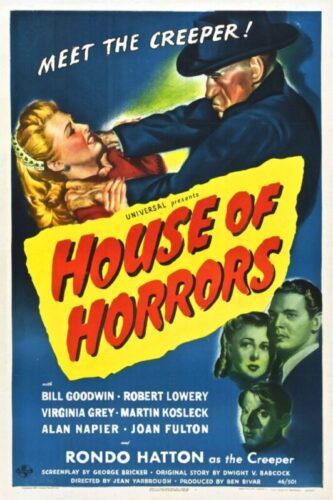
When the latest work of penniless sculptor Marcel De Lange is mauled by cruel critic F. Holmes Harmon, the artist goes to the docks to end his pitiful existence, but instead saves a life — that of the wanted murderer known as The Creeper. Inspired by the man’s unusual features, De Lange starts a new piece of work, but in addition to using his new found friend as a model, the sculptor also employs him as a weapon, tricking the brute into silencing his critics. Reporter Joan Medford investigates, and Police Lt. Larry Brooks is also on the case, but he suspects Joan’s boyfriend Steven Morrow who lives beside Marcel….
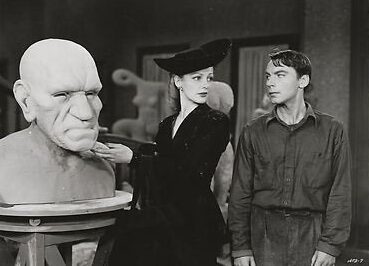
Rondo Hatton holds a unique position in horror film history. He suffered from acromegaly, a disease which causes bones to increase in size and create serious disfigurement. A World War 1 hero, his exposure to poison gas in World War I may have been the cause of his illness, though has been disproved by many. His appearance attracted the attention of Universal Studios, who realised that they could save a lot of money by casting an actor who didn’t require any makeup to look monstrous, as well as exploit said fact, though he spent many years as a “blink and you’ll miss him” bit part actor before he became famous. Of course by today’s standards this seems rather cruel, but a lot of people wouldn’t have thought anything of it back in the 1940’s. He was first cast as The Creeper, a super-strong murderer who broke people’s backs under the control of a revenge-seeking villain, in The Pearl Of Death, an installment in the Basil Rathbone Sherlock Holmes series. Despite the fact that he was kept in shadow until the final reel, he was such a sensation that Universal decided to make a series featuring Hatton as basically the same character, though in the end only two further films were made because Hatton soon died from his ailment, to receive a military burial with honours and eventually have the Rondo Award, which The American Horror Film Board presents every year to deserving horror films and actors since 2002, named after him. House Of Horrors is the second of his three movies as The Creeper [elsewhere he played the likes of “Moloch the Brute”] and is a fairly basic effort, employing the simple revenge plot that Universal employed over and over again, though the fact that it’s critics who are the victims means that this looks forward to Theatre Of Blood, and the very fast pacing certainly helps to make it decent viewing, while Martin Kosleck is a memorable villain. As for Hatton, he’s simply required to
The titles, which have Hatton’s shadow moving around behind them, claim that this film is “introducing Rondo Hatton as The Creeper”, which is totally incorrect. Anyway, we’re inside the main workroom of Marcel, the camera giving us a look around it with busts all over the place. Marcel is with his cat, unable to give it milk because all he has is bread and cheese which is borrowed. He has no money and has to sit with candles as he can’t afford the heating bill, though the place doesn’t look as dark as it should look. We feel very sorry for Marcel irght now, though that will soon change. There’s a knock at the door and in comes Holmes Harmon, an art critic who’s come over to see and judge Marcel’s latest work, accompanied by a Mr Samuels. When Marcel tells him the name that he’s given to his new creation, the arrogant Holmes replies “and I call it tripe, pure unadulterated tripe with an overtone of sheer lunacy”. Marcel kicks them both out, smashes his work and goes out to throw himself into a river but ends up rescuing someone instead. “Magnifique, the perfect Neanderthal Man” he says as he gets his first proper look at the guy, who wakes up in bed with Marcel looking after him. “Don’t you know who I am”?, aren’t you afraid of me”? he asks his saver. He’s rather vulnerable here, especially when he tells Marcel he’s his friend. He’s obviously a very lonely guy whose looks tend to scare people away. Unfortunately, he’s also a psychopathic killer, and when Marcel is out promptly goes out himself to follow a woman on a very familiar but wonderfully lit street set. Usually in films of this vintage a lady walking on the street on her own is intended to be seen as a streetwalker of the other kind, and this one certainly seems to know that she’s being followed and slowly gets out a cigarette before asking him if he has a light, the obvious pickup line, but what’s most interesting here is that The Creeper, as indeed he says a couple of scenes later, only seems to kill her because she screams. Maybe he was actually going to try to have sex with her?
When the body is found, the murder echoes an earlier one, “one of The Creeper’s little jobs”, though The Creeper’s now dead, isn’t he? Marcel realises what he’s done but doesn’t seem fazed; on the contrary, he realises that his guest could be very useful. Holmes has written a nasty bit in the paper about his work, so Marcel says how angry he is and how he’d like to kill him. Sure enough, The Creeper is keen to help his sole friend and sets off to kill again. The screenplay by George Bricker really likes to show us how unpleasant Homes is so that we’re actually wishing his death.Co-worker Joan comes into Harmon’s office and discovers that Harmon is writing a cruel review of her boyfriend Steven’s painting display, which he considers to be cheesecake for the lower orders. However, he’s rather taken with Joan, and compliments her and asks her out to dinner as well as seeeming to realise that his views and attitude could do with changing – only for us to then see on his typewriter as The Creeper creeps up behind him that he’s written about Joan stupidly trying to change his mind about Steven. Steven is the chief suspect because he had an altercation with Holmes previously where he threatened to ring his neck, while Lt. Larry Brooks rather likes Marcel’s latest long suffering model Stella. Meanwhile Joan pays a visit to Marcel because he’d also been the victim of Holmes’s bile. Marcel is proud of the large bust of The Creeper’s head he’s making, but he doesn’t want Joan to see it, nor indeed any evidence of The Creeper being there at all, though he really fancies Joan. As another art critic, Hal Ormiston, also comes into the story, we can predict much of what will happen, but the plot is fairly well put together if rather too neat at some point.

The lead-ups to the kills are well done, and we surprisingly get a backbreaking in silhouette. The Creeper gets to do some good menacing of the heroine in time-honoured fashion before slain rather easily until a voice over leaves things open for his return. One can certainly regard the handling of Hatton as shameful, and he wasn’t a trained actor either, though he’s able to add slight touches of pathos to his character even if they’re not in the script. In particular he has sensitive eyes, which makes one wish that the script had carried on in the way his early scenes suggest, creating sympathy for this rejected outcast in the manner of the Frankenstein Monster in his earlier incarnations, rather than just have him go around stalking and killing people, though on the other hand his appearance as a real walking nightmare must have frightened many at the time, which was of course what was intended. Kosleck, usually busy playing Germans, is mostly very good except for when his French accent slips, but is also hampered by a rushed script which focuses on action at the expense of character. One minute he’s a sad individual, one whom we sorry for because he’s so down on his luck, and the next minute he’s plotting murders. There’s no sense of an evolvement here, and he quickly becomes someone we hate and fear. Perhaps most interestingly, he seems a bit camp, as does Alan Napier’s Holmes who’s wonderfully horrid, so much so that we don’t think it in bad taste when Steven throws a party with other artists to celebrate his death. He almost steals the first third of the film, while Virginia Grey’s Joan is marvelously spunky and rather sexy, and gets an interesting scene with a top-billed Robert Lowery as Steven where he expresses dislike for the way her job has her going all over the place, even crying “I won’t stand for it”. The terrific response is,“then you’d better get yourself a nice, comfortable, fireside type, she’ll bore you to death at least you’ll always know where she is”. Unfortunately the very last scene has her imply that she’ll give up working to become Steven’s wife. Of course that was the norm back in 1946, but it’s disappointing considering the rather modern attitudes displayed earlier.
Director Jean Yarborough was another journeyman director, his most frequent collaborators being Abbott and Costello, who briefly became a horror filmmaker and was reasonably good at it. Some interesting camera setups, usually involving characters, suggest that and cinematographer Maury Gertsman were attempting to do what they could with the material in the limited time which they had. There’s one very fine shot of somebody discovering the corpse of a lady, with only her legs shown, in the background while in the foreground is a painting of a skinny girl with long legs. Some material is understandably flat looking and interior sets tend to be very sparse except for the pottery room, but one can see elements of what was becoming film noir creeping in, including a certain cynicism in the script. Unfortunately, said script has one major gaffe; we’re told that Holmes’s body was discovered at 11am, but in the next scene Steven says that he was in a bar with fellow artists when they got word that the critic was murdered at 2am. The rushed nature of the production was no doubt also the reason for not one but two lousy sketches of Hatton that are done. But House Of Horrors is relatively exciting, with nary a slow or dull moment. And it may ignite a [perhaps morbid] interest in the the work of Hatton. It’s certainly making me, having only previously seen the Sherlock Holmes episode, take a look at his other films.
SPECIAL FEATURES
Brand new audio commentary tracks with author Stephen Jones and author / critic Kim Newman
I was hoping for a lot of discussion about Hatton, whom Jones thinks that we should reassess in terms of his treatment by Universal, and we certainly get it, along an amazing true story about an actor, Paul Benedict, who was spotted by a doctor on a TV show who noticed that he was in the early stages of acromegaly, rang him up and cured him. Jones also tells us the sad fact that Kosleck, despite being really the main character, was paid less than all the other main cast members, while Newman makes a case for Yarborough being underrated and loves the matter of fact look at craziness and monsters in these late Universal horrors, and explains that there was some relaxation of censorship during the later war years. Both make a strong case for the movie too, their effects certainly making me appreciate it a bit more than I did after first viewing.
Stills Gallery
SET SPECIAL FEATURES
Limited Edition slipcase [2000 copies]
1080p presentation of all four films across two Blu-ray discs
Eureka seem to be using the old-ish transfers used to Scream Factory but doing new scans. Murders In The Zoo looks the weakest of the four, but then it’s by far the oldest of the films. The picture is quite soft, grain is pretty thick, and there’s a vertical present through most of the final third, but this is still good for a 1933 movie, and the audio is quite amazing in its clarity. Night Monster is mostly very good indeed, with quite extraordinary depth of field and stunning blacks, though every now and again a few shots look noticeably weaker, plus what looks like a whole reel; here there’s clearly serious degrading of the image, with some haziness, flickering and damage. Horror Island looks a bit inferior overall, with mild scratches and speckling, but at least its look is consistent; the detail isn’t hugely sharp but blacks again are very strong. House Of Horrors is often lacking in texture and suffers from a lot of grain imbalance, though it’s still pretty decent for a 1946 film. It seems that Scream Factory, from whom Eureka got these prints, did some digital tinkering on this one to make things sharper and clearer. This never improves matters, but companies still do it anyway. Eureka no doubt did a new encode, which has probably helped, though maybe not as much as desired. At the end of the day my fussy complaints are largely because we’ve been spoiled by incredible transfers of vintage movies of late. Brand new HD masters of these movies are unlikely to happen due to their limited appeal, so let’s just appreciate what we do have.
Optional English SDH
A limited edition collector’s booklet featuring new writing by Craig Ian Mann and Jon Towlson [2000 copies]
Quality varies only slightly in this well chosen selection of lesser chillers from the Universal vaults, with “Night Monster” the standout for me, while as usual the commentary tracks provide excellent added value. Recommended.





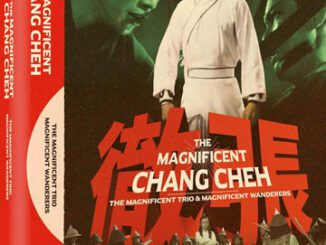

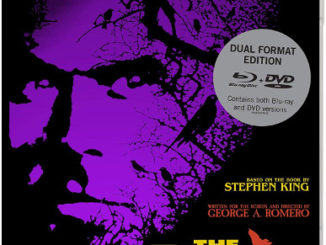
Be the first to comment